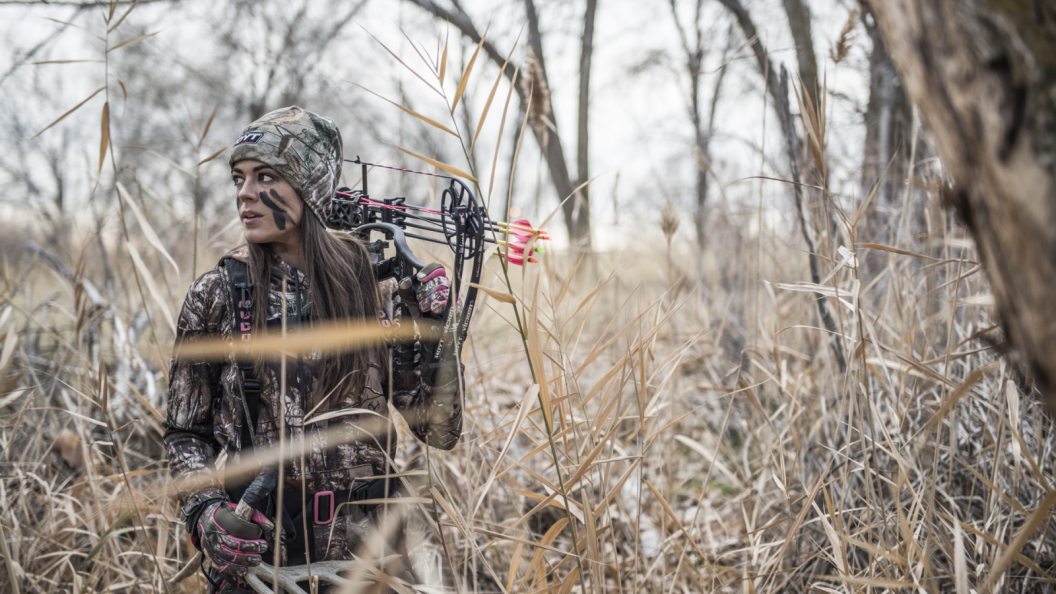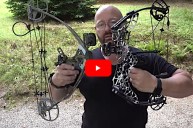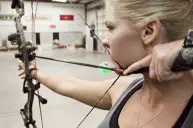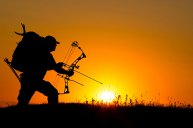Learning to bowhunt as a beginner can be hard: In addition to mastering the basics of shooting a bow, in the field you have to stalk your target to within a few dozen yards, quietly knock an arrow, and take your shot. But this greater challenge can reap bigger rewards:
One of the unique joys of bowhunting is the chance to get close to your target animal, says Matt Anderson, who oversees guided hunts as the senior director of operations and recreation at Brush Creek Ranch in Wyoming. He tells Wide Open Spaces, "You get to see and witness many unique moments that otherwise would not be experienced from several hundred yards away while rifle hunting."
Moe Newman, a Yeti brand ambassador and bowhunter from Louisiana where she owns Journey South Outfitters, adds that with a rifle, you take an animal at a very far distance. "With bowhunting, you're in [the animal's] space. You're hunting for the true purpose of hunting: the chase, the experience, the time and effort spent in the woods."
As with any new sport, bowhunting can be intimidating to get into—especially for women. While states across the country are seeing more women bowhunting, it remains a largely male-dominated sport with many barriers to entry for women, among them finding good mentors and hunting clothing that fits women properly. Thankfully, the rise in females who bowhunt has also increased the number of women's specific courses and gear.
Want to get started? We break down the basics of choosing your first set of bowhunting gear, connecting to the women's bowhunting community, and getting ready for your first bowhunt.
How to Choose the Right Bowhunting Gear
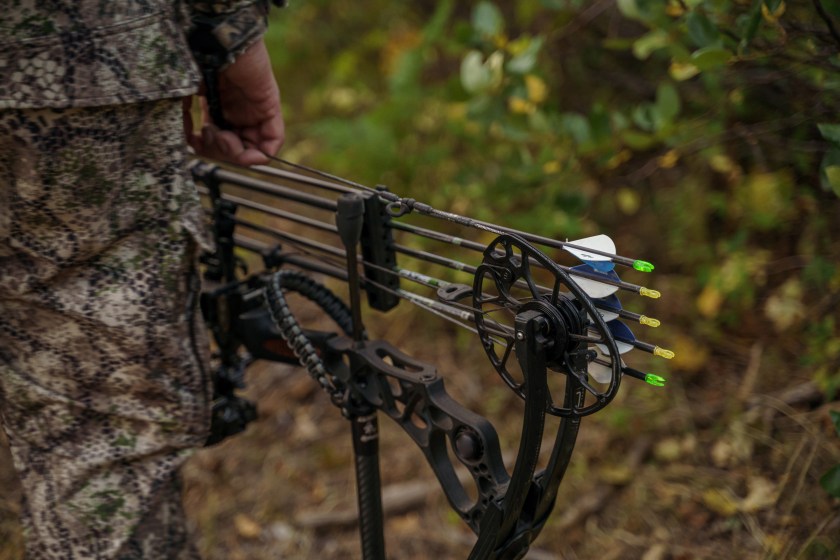
Getty Images, Fly View Productions
Finding the right gear for bowhunting can be difficult. Not only are there so many different types of bows and arrows, but much of it isn't women-specific. "The world of bows gets very complex, from choosing broadheads and arrow fletching, to what type of release to get," Newman tells Wide Open Spaces.
1. Choose Your Type of Bows
First, you have to determine what kind of bow you want to use for bowhunting: longbow, recurve, compound, or crossbow. Each type has its pros and cons and will alter your style of hunting.
Don't be afraid to go to your local bow shop to handle the different styles in order to choose the bow that most appeals to you. When you think of Robin Hood, you're imagining a longbow. Longbows are just what they sound like: a long wooden stave that is strung with a bowstring. Longbows are "traditional" bows and are incredibly simple, but can also be difficult to draw and shoot accurately. Recurve bows are similar to longbows, except that both ends curve away from the archer. This curve makes shots more powerful than with a longbow. Like longbows, recurves can be difficult to draw and aim. They can be a great, affordable weapon for a beginner bowhunter, but it takes dedication and practice to master them. Compound bows are the most popular choice for bowhunters. Unlike traditional bows, they have a system of pulleys, cams, and cables that allow archers to draw heavy weights with little effort. Compound bows also have a draw let-off; once you get over the initial strain to draw the bow, the pulley and cam system takes over and you can hold the bow steady to aim with little effort. Crossbows look like compound bows turned on their sides. Unlike other bows, they have a trigger release mechanism. The simple point-and-shoot method of firing them makes them the easiest bow to shoot. However, in most states, it is only legal to hunt with crossbows during rifle or shotgun season, so they're not the most versatile option if you're intent on mastering the bowhunt.
2. Pick the Right Bow Fit and Weight
Like a lot of sporting equipment, bows come in sizes, and figuring out which best fits is paramount.
Bows are sized off of draw lengths, or how far you have to draw back the bowstring. Women are generally shorter and have a shorter wingspan than men, so we need a shorter draw length. Because of this, bows designed specifically for women (and youth) are often just smaller versions of men's bows. To dial in your correct size, measure your draw length—defined as your wingspan divided by 2.5—and look for a bow that is within that range.
Bows also come in different draw weights, which is the amount of strength, in pounds, that you need to pull against a bowstring to fully draw a bow. Higher draw weights in excess of 60 or 70 pounds make for a more powerful shot but can be difficult to aim and will quickly fatigue you. Lower draw weights—like 35 pounds—shoot slower arrows but make it easier to control the bow. Most compound bows have adjustable draw weights, which is another feather in their cap for choosing this style.
To find the perfect bow fit, head to a hunting store that carries a wide variety of bows and work with sales associates to find one that works for you. Newman recommends starting with low poundage so you can learn proper form when drawing your bow and get comfortable holding the bow at full draw and smoothly releasing it. "A bow shop will set you up with the right draw length, the right arrow length, and the right arrow weight," she says.
3. Know Which Arrow You Need
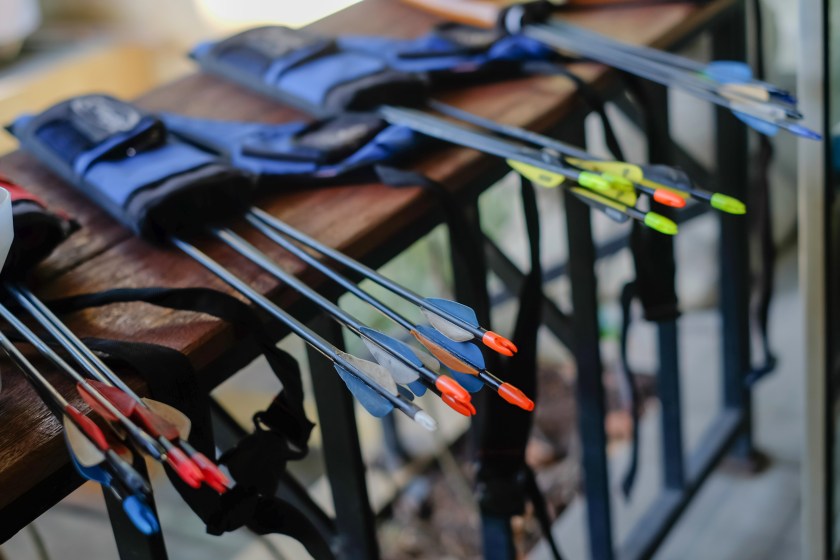
Getty Images, Kanawa_Studio
There are numerous considerations to take into account when choosing arrows, from weight and length, purpose to material, and fletching to projectile. Further, different types of arrows are designed for different purposes. Target and competition arrows are, you guessed it, mostly used for target archery. Traditional arrows are made of wood and have real feathers for fletching, and are used for traditional archery, with a longbow. Lastly, there are hunting arrows, which are typically heavier to increase their speed and impact power. Here's what to look for when shopping for your bowhunt.
- Material: Arrows come in a variety of shaft materials. Stay away from wood unless you're shooting a wooden longbow. Carbon, aluminum, and carbon-aluminum composite arrows are your best bet for hunting, especially with compound bows.
- Length and weight: When choosing the length and weight of your arrows, the decision is often already done for you; bow manufacturers list the size and weight of arrows you should be shooting with that bow. The most important thing is to never shoot an arrow that's too short for your bow or draw length; arrows that are too short won't sit well on the bow when drawing and can be dangerous.
- Arrowheads: Arrows are tipped with different arrowheads, depending on what they're being used for. Bullet and field points are designed to be shot at targets. Blunt points are used for small game animals and kill by shock rather than piercing. Broadheads are specifically for hunting and are designed to fly accurately, penetrate skin, and cut vital organs to kill quickly. There are many different kinds of broadheads, and just as many opinions on what broadhead you should use. As you continue to shoot, you'll find your favorite. Just make sure to use a broadhead that is capable of ethically taking down whatever game you're targeting.
4. Consider Bow Accessories
Once you've got your bow and arrows, you'll need a few additional accessories:
- Bow sights, which are similar to rifle scopes, are crucial for accuracy
- Arrow rests give you a platform to set the arrow on before shooting
- Quivers store your arrows and give you easy access to them while shooting
The rest of the necessary equipment overlaps with other types of hunting. You'll need:
- The proper clothing to hunt, as well as boots and a backpack
- Depending on what you're hunting and where, you may need treestands or ground blinds
Connect With the Bowhunting Community
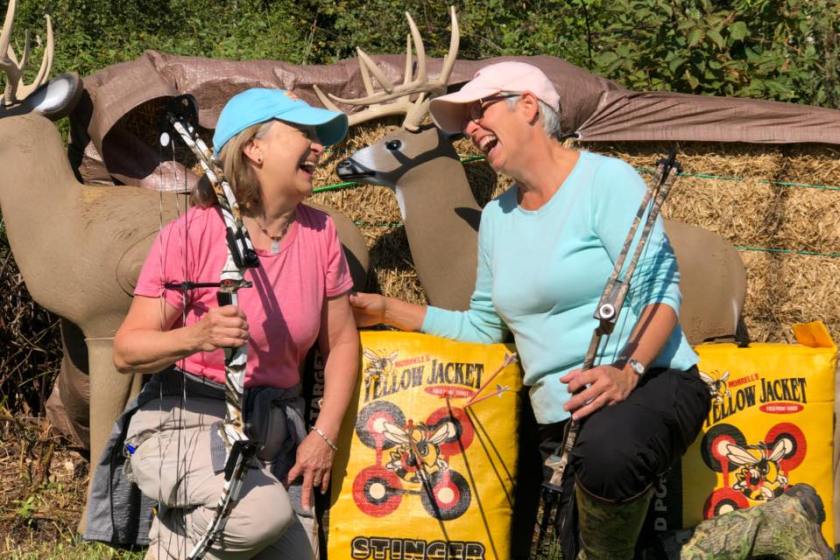
Leading Ladies Outdoors, Facebook
Even with all the right gear, you still need to know how to use it, where to bowhunt, what tags and licenses to get and, if you haven't hunted before, what to do with the animal once it's down.
If you don't have a family member, partner, or friend to help guide you, it can be overwhelming to take all of this on alone. Having a mentor to help you learn bowhunting makes the process a lot smoother.
Newman also stresses the importance of women meeting other women who bowhunt. "It gives [you] a sense of encouragement. You help them overcome any self-doubt they may have about being a bowhunter [and] you can share your stories of both success and defeat," she says.
Thankfully, there are plenty of courses and clubs to help connect you to the bowhunting and archery communities.
1. All-Women's Courses
As a woman bowhunter, the resource you must become acquainted with first and foremost is Becoming an Outdoors Woman (BOW). This nonprofit runs all-women's outdoor hunting workshops in 38 states and some Canadian provinces. BOW hosts bowhunting classes as well as hunter education classes and courses on field-dressing animals. BOW classes are also a great place to meet women to go bowhunting with.
For a more intensive course, Leading Ladies Outdoors hosts women's bowhunting academies in Fall Creek, Wisconsin at a 5,000 square foot lodge on 145 acres. Founder Tammy Koenig has been bowhunting for 40 years and is a certified bowhunting and archery instructor. She began teaching bowhunting classes for BOW in 1991, making her the first recorded woman to host an all-women's bowhunting class.
2. Local Archery Clubs
Although archery doesn't always have the hunting aspect to it, local archery clubs are a great place to learn about the sport, get some practice with your bow, and meet other archery enthusiasts. You can search USA Archery for local clubs as well as certified archery coaches if you want one-on-one training near you.
3. Guided Bowhunts
Going on a guided bowhunt is a great way to learn from the experts and get professional advice when you're green. Guided hunts are dependent on location and season, but websites such as Book Your Hunt offer databases of hunts throughout the world and are a great place to start.
Get Bowhunting Practice
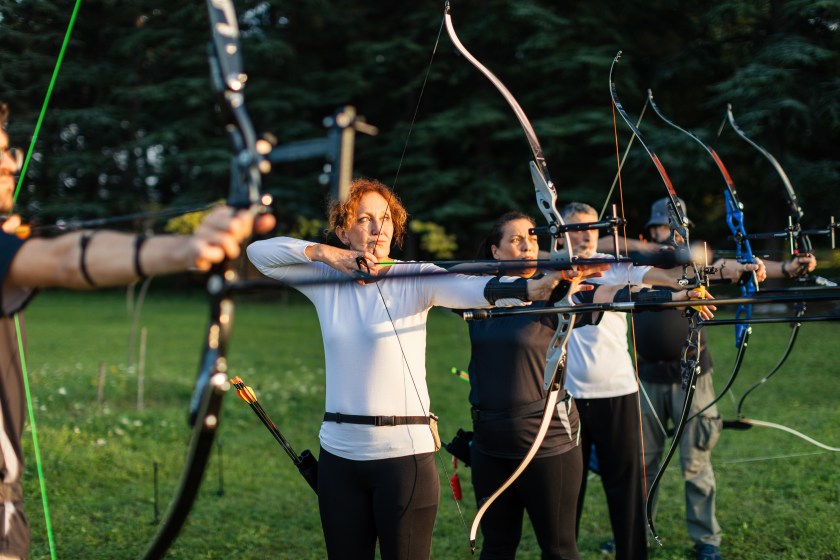
Getty Images, miljko
Once you've gotten your equipment and have had some coaching on how to use it, the most important thing you can do is practice. Don't wait until archery season to pick up your bow—get out to the range and shoot as often as you can. The only way to get better is to shoot at different distances, in different shooting positions, and at different speeds.
If you have an upcoming hunt, practice with arrowheads that are of a similar weight to the broadheads you'll use; arrowhead weight affects an arrow's trajectory, so you'll want to dial in your aim with a similar weight.
If you're having trouble motivating yourself, join a local archery club or hire a coach to give you the extra push. If you live far from a range or can't shoot often, give yourself a leg up by incorporating bow-specific strengthening exercises into your life. Exercises like single-arm dumbbell rows, bench dips, planks, and pushups will all strengthen your core and upper body, and give you better bow control.
According to Anderson, one of the biggest challenges women face in bowhunting is the strength required to pull back compound bows. "Although technology has drastically changed over the years making the newer equipment much more user-friendly and easier to pull back, it's still hard and certain states require minimum draw weights which can be difficult for some women to accomplish."
Make Final Preparations for Your Bowhunt
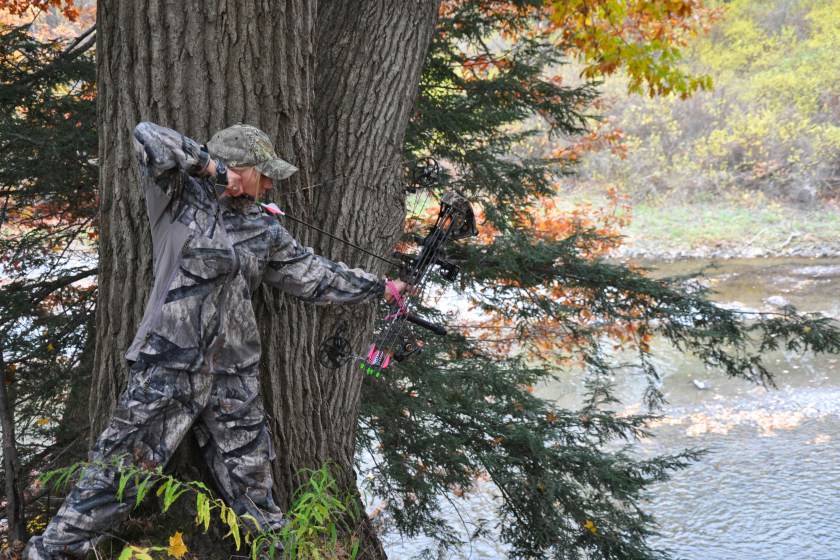
Getty Images, DLCcreates
You've put in the hard work to buy the gear, get connected, and get the practice. Now it's time to get out and hunt! Every hunt requires a lot of prep work, but a bowhunt in particular requires some special considerations. Namely:
- Take an online safety course. Make sure you get your bowhunter education course out of the way, as this is a requirement for a bowhunt license. The online safety course teaches you generally how to hunt safely and explains the bowhunting laws and regulations in your state.
- Get your hunting license and tags. Anyone hunting, whether with a gun or a bow, needs a hunting license. These differ in price depending on the state and can typically be bought online through your local wildlife agency's website. You'll also have to determine if you'll need any special tags for the game species you're targeting. The tags can get complex, depending on the state and species, so your best bet is to talk to a hunting store or a wildlife officer.
- Find a place to bowhunt. If you don't have your own land to hunt on, you'll have to find public lands to hunt on or request hunting access from private landowners. To bowhunt on public lands, look for state and national forests, wildlife management areas, or national wildlife refuges.
- Read up on the regulations. Different areas and different animals have various hunting regulations and seasons. Once you know where and what you'll be hunting, you have some reading to do, most likely on your state's wildlife agency website. You'll also want to make sure your bow draw weight is over the minimum set by the regulations for the animal you're targeting to help ensure an ethical kill.
- Start scouting your hunting area. Look for signs of the animals you're targeting, like fur, scat, and tracks, and identify places you can hunker down in either a ground blind or treestand.
Once the prep work is done and archery season is open—typically early fall, depending on the state—put your newfound skills to the test and get out bowhunting!
READ MORE: How to Get Your Bow Ready for Deer Season
